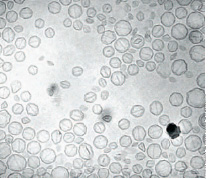4.5: Act Like a Membrane
- Page ID
- 211482
Researchers know that high concentrations of chemotherapy drugs will kill every single cancer cell growing in a lab dish, but getting enough of these powerful drugs to a tumor in the body without killing too many healthy cells along the way has been exceedingly difficult. These powerful drugs can do more harm than good by severely sickening a patient during treatment.
Some researchers are using membrane-like particles called liposomes to package and deliver drugs to tumors. Liposomes are oily, microscopic capsules that can be filled with biological cargo, such as a drug. They are very, very small—only one one-thousand the width of a single human hair. Researchers have known about liposomes for many years, but getting them to the right place in the body hasn't been easy. Once in the bloodstream, these foreign particles are immediately shipped to the liver and spleen, where they are destroyed.
Anesthesia Dissected

Scientists who study anesthetic medicines have a daunting task—for the most part, they are "shooting in the dark" when it comes to identifying the molecular targets of these drugs. Researchers do know that anesthetics share one common ingredient: Nearly all of them somehow target membranes, the oily wrappings surrounding cells. However, despite the fact that anesthesia is a routine part of surgery, exactly how anesthetic medicines work in the body has remained a mystery for more than 150 years. It's an important problem, since anesthetics have multiple effects on key body functions, including critical processes such as breathing.
Scientists define anesthesia as a state in which no movement occurs in response to what should be painful. The problem, is even though a patient loses a pain response, the anesthesiologist can't tell what is happening inside the person's organs and cells. Further complicating the issue, scientists know that many different types of drugs—with little physical resemblance to each other—can all produce anesthesia. This makes it difficult to track down causes and effects.
Anesthesiologist Robert Veselis of the Memorial Sloan-Kettering Institute for Cancer Research in New York City clarified how certain types of these mysterious medicines work. Veselis and his coworkers measured electrical activity in the brains of healthy volunteers receiving anesthetics while they listened to different sounds. To determine how sedated the people were, the researchers measured reaction time to the sounds the people heard. To measure memory effects, they quizzed the volunteers at the end of the study about word lists they had heard before and during anesthesia. Veselis' experiments show that the anesthetics they studied affect separate brain areas to produce the two different effects of sedation and memory loss. The findings may help doctors give anesthetic medicines more effectively and safely and prevent reactions with other drugs a patient may be taking.
Materials engineer David Needham of Duke University in Durham, North Carolina, is investigating the physics and chemistry of liposomes to better understand how the liposomes ad their cancer-fighting cargo can travel through the body. Needham worked for 10 years to create a special kind of liposome that melts at just a few degrees above body temperature. The end result is a tiny molecular "soccer ball" made from two different oils that wrap around a drug. At room temperature, the liposomes are solid and they stay solid at body temperature, so they can be injected into the bloodstream. The liposomes are designed to spill their drug cargo into a tumor when heat is applied to the cancerous tissue. Heat is know to perturb tumors, making the blood vessels surrounding cancer cells extra-leaky. As the liposomes approach the warmed tumor tissue, the "stitches" of the miniature soccer balls begin to dissolve, rapidly leaking the liposome's contents.
Needham and Duke oncologist Mark Dewhirst teamed up to do animal studies with the heat-activated liposomes. Experiments in mice and dogs revealed that, when heated, the drug-laden capsules flooded tumors with a chemotherapy drug and killed the cancer cells inside. Researchers hope to soon begin the first stage of human studies testing the heat-triggered liposome treatment in patients with prostate and breast cancer. The results of these and later clinical trials will determine whether liposome therapy can be a useful weapon for treating breast and prostate cancer and other hard-to-treat solid tumors.

David Needham designed liposomes resembling tiny molecular "soccer balls" made from two different oils that wrap around a drug.
LAWRENCE MAYER, LUDGER ICKENSTEIN, KATRINA EDWARDS

